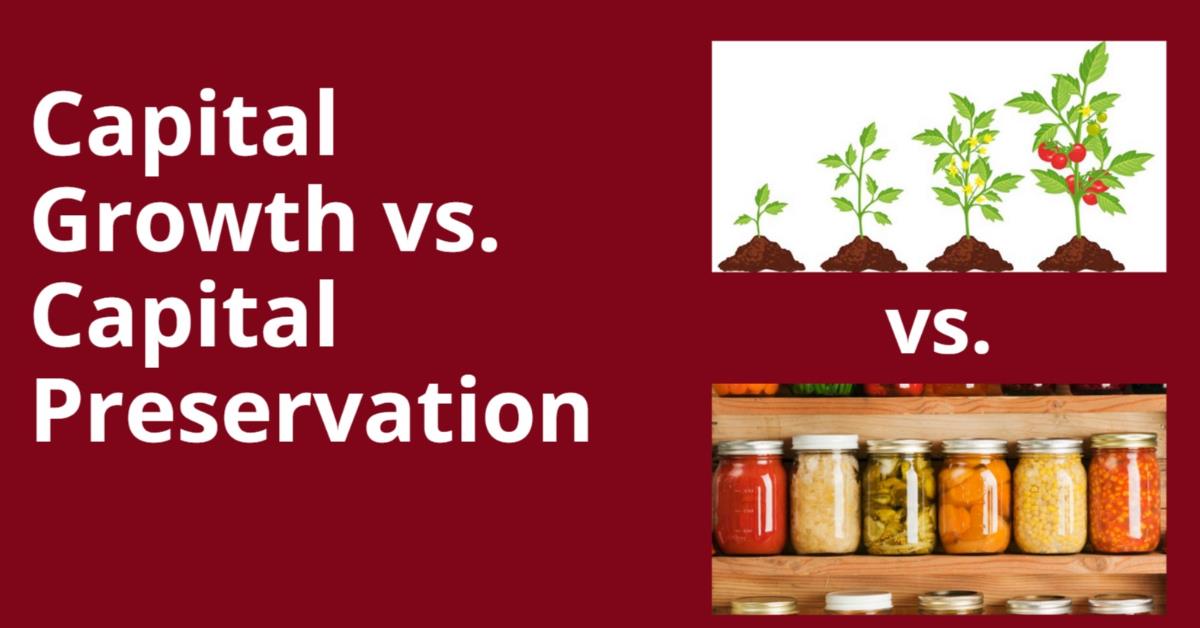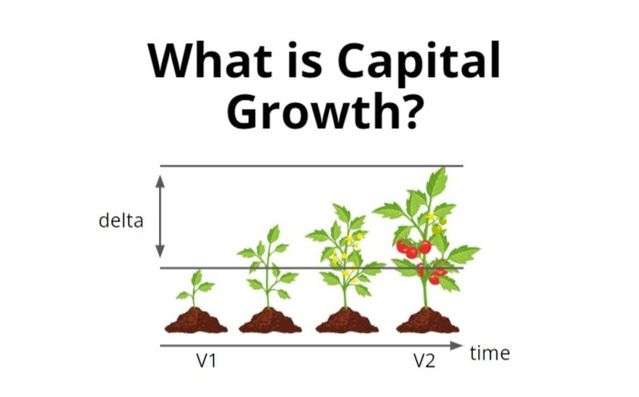Capital Growth vs. Capital Preservation
Capital growth and Capital preservation are investment approaches with different characteristics that you should be aware of before deciding between the two.last updated Monday, March 24, 2025
#capital preservation #capital preservation strategy
| | by John Burson |

QUICK LINKS
AD
Get access to EB 5 Visa Investment Projects
Capital growth and Capital preservation are sound investment strategies. Yet, they are entirely different approaches to investing. So, before deciding between the two, you should know both approaches' tradeoffs, tax implications, market forces, and pitfalls.
After you finish this article, you should know the following:
- How to compare capital preservation vs. growth
- Their relation to risk tolerance and risk management
- Their advantages and disadvantages
- Which strategy may be right for you
What is Capital Growth?

fig 1 . Capital Growth
Capital growth is an investment approach that focuses on increasing the value of your investments over time. You can measure capital growth results by determining the difference between an investment's current value, V2, and its original purchase value, V1, or delta = V2 - V1.
The following simple formula can calculate returns on investment:
Return On Investment, ROI = 100%*(V2-V1)/V1
Example:
V1, original purchase price $100 on January 1st, 2020
V2, the new market price of $120 on January 1st, 2023
ROI=100%*(120-100)/100=20%
Note: The 20% ROI is a total growth over three years of investment; most rates are annualized.
In a simple calculation, you may divide 20% by 3 to receive an annualized return on investment.
Most investors use a capital growth strategy to invest in equities and tangible assets with moderate to high growth potential.
Since capital growth investments can produce high returns in exchange for higher risk-taking, investors with a high-risk tolerance and the willingness to hold an asset for an extended period gravitate toward a capital growth asset allocation.
Some growth investors may only sell their growth investments to pass them on to their heirs (long-term growth).
Moderate growth portfolios primarily have equities in well-established companies like Amazon (AMZN) and Microsoft (MSFT).
Conversely, high capital growth portfolios usually have more speculative assets, such as Meta Platforms (META) and Qualcomm (QCOM).
What is Capital Preservation?
Capital preservation is an investment strategy that focuses on capital preservation and portfolio loss prevention. Investors execute this strategy by primarily investing in ultra-secure short-term investments, such as certificates of deposits (CDs), savings accounts, and Treasury bills. This passive investing strategy's main financial objective is to cover the inflation rate.
Capital preservation investments usually appeal to investors who lack the time or resources to recover from a significant asset loss. This characteristic is why most retirees favor capital preservation; they don't want to outlive their savings.
What Does Risk Tolerance and Risk Management Have to Do with It?
The current income from high-yield bonds and dividend-paying stocks appeals to investors with a low-risk tolerance (risk-averse) because they value a quick and predictable return, even though the real rate of return can be meager or near zero.
Since they focus on preserving capital and portfolio protection, risk-averse investors believe the low-risk current passive income stream is worth the tradeoff of possible high returns from growth investments.
On the other hand, most growth investors hold little regard for current income in favor of capital appreciation. Their high-risk tolerance makes them willing investors in riskier growth stocks with high price-earning (P/E) ratios.
However, most capital growth investors aren't stock market daredevils. Instead, they mitigate their risks through extensive research, portfolio diversification, and dollar cost averaging. In addition, they can tailor their asset allocation to their risk tolerance and projected investment horizon.
Capital Growth Advantages
Capital growth offers advantages that can advance your objective. However, it has disadvantages that could impede or deconstruct your investment activity. Here are the most prominent advantages and disadvantages of capital growth.
- Tax Benefits
Capital growth assets are long-term investments. So, even if one of your assets appreciates exponentially in a year, you won't need to pay taxes on the gain unless you sell the asset. Also, experienced real estate investors can get a tax deduction using a complex negative gearing strategy. - Great Profit Potential
If your capital growth strategy works, you could benefit from impressive returns. For example, Microsoft shares cost an average of $15.49 per share in 1998. Presently, Microsoft shares cost an average of $241.22 per share. So, if you had invested $5,000 in the company's shares in 1998, your shares would be worth $77,860.99 today.
Capital Growth Disadvantages
- Substantial Opportunity Cost Risk
Many capital growth assets have low liquidity, leaving you open to opportunity cost risk. Opportunity cost is the difference between two investment options. For example, suppose you chose to invest $160,000 in California real estate instead of gold in 2001, and in 2021, you sold your investment for an $805,100 net profit. However, if you had invested that amount in gold back then, your gold investment would be about $923,200 today. Your opportunity cost would be $118,100. - High-Risk Factor
Unfortunately, not all capital growth investments are Microsoft success stories. Only a tiny percentage led to skyrocketing appreciation over a 20-year investment horizon.
For this reason, asset volatility is a critical concern with capital growth investments.
Capital Preservation Advantages
- Minimal to Low-Risk Levels
Short-term, fixed-income investments like CDs and US Treasury notes provide low-stress investing for capital preservation investors. Most of these fixed-income investments are government-backed. Some investors will also use a capital preservation strategy to safeguard their capital until market conditions improve. - Safe and Stable Returns
Capital preservation investments like government bonds and money market accounts are the safest and most stable investments. Also, you are not required to do due diligence or management duties.
Capital Preservation Disadvantages
- Lack of Options
Due to volatile domestic and global market conditions, the list of capital-preserving markets is getting smaller. In addition, current inflationary pressures contribute to the problem. - Minimum to near-zero returns
Volatile marketing conditions make finding capital preservation investment options that offer a decent return difficult. As a result, you end up settling for fixed-income investment options with very low or near-zero returns.
Which is the Best Strategy for You?
At this point, you should thoroughly understand how these investment approaches can fit into your investment plans. For example, capital preservation is your best investment strategy if you want to play it safe with your investment portfolio. Alternatively, you can always switch plans or use a combination if your situation changes.
Frequently Asked Questions
How Much Money Should I Commit to Growth Capital Investments?
The amount of money you commit to a capital growth investment is entirely up to you. However, since these assets have a long-term investment horizon, experts advise investing in growth with money you can do without for at least five years.
Can I use a growth and preservation objective at the same time?
Yes, you can use both strategies simultaneously. However, you may need to reassess your goal before trying it because you will not pursue a core objective.
Is a capital growth objective more successful than a capital preservation strategy?
Considering the widely accepted premise that long-term returns can overcome short-term volatility, a capital growth strategy has better potential to be more successful than a preservation strategy, especially when factoring in inflation.
Story Profile
| Story Index | XKHGS | |
| Last update | Monday, March 24, 2025 | |
| Story Sources | ||
| Story Nominated by | @whypronin, @paperfreenow | |
| Story Author(s) | ||
| Story Editor(s) | Yury Pronin | |
| Tailored for | Investor | |
| Keywords | capital preservation capital preservation strategy capital preservation vs growth | |
| Social hashtags | #CapitalGrowth #RealEstate | |
| Linked companies | NA | |
| Topics | Investment Strategy | |
| Regions | National | |
| Industries | Real Estate | |
| Related information |
Free Consultation
Similar Pages
- Capital Growth Investments. Is Capital Growth the Best Strategy for You?

- How Do Smart Investors Benefit from Capital Preservation? Capital preservation strategies.

Popular
Benefits of the EB-5 Visa Program | Guide
Search within Paperfree.com
